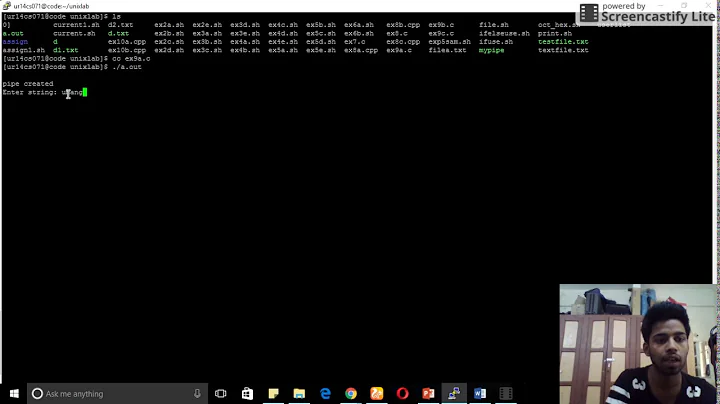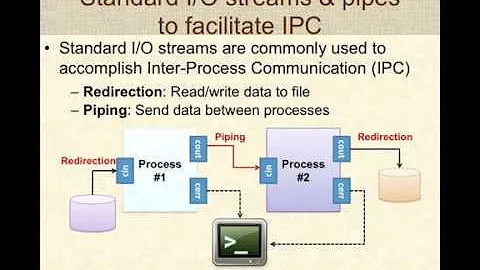How can I send the stdout of one process to multiple processes using (preferably unnamed) pipes in Unix (or Windows)?
Solution 1
Editor's note:
- >(…) is a process substitution that is a nonstandard shell feature of some POSIX-compatible shells: bash, ksh, zsh.
- This answer accidentally sends the output process substitution's output through the pipeline too: echo 123 | tee >(tr 1 a) | tr 1 b.
- Output from the process substitutions will be unpredictably interleaved, and, except in zsh, the pipeline may terminate before the commands inside >(…) do.
In unix (or on a mac), use the tee command:
$ echo 123 | tee >(tr 1 a) >(tr 1 b) >/dev/null
b23
a23
Usually you would use tee to redirect output to multiple files, but using >(...) you can
redirect to another process. So, in general,
$ proc1 | tee >(proc2) ... >(procN-1) >(procN) >/dev/null
will do what you want.
Under windows, I don't think the built-in shell has an equivalent. Microsoft's Windows PowerShell has a tee command though.
Solution 2
Like dF said, bash allows to use the >(…) construct running a command in place of a filename. (There is also the <(…) construct to substitute the output of another command in place of a filename, but that is irrelevant now, I mention it just for completeness).
If you don't have bash, or running on a system with an older version of bash, you can do manually what bash does, by making use of FIFO files.
The generic way to achieve what you want, is:
- decide how many processes should receive the output of your command, and create as many FIFOs, preferably on a global temporary folder:
subprocesses="a b c d"
mypid=$$
for i in $subprocesses # this way we are compatible with all sh-derived shells
do
mkfifo /tmp/pipe.$mypid.$i
done
- start all your subprocesses waiting input from the FIFOs:
for i in $subprocesses
do
tr 1 $i </tmp/pipe.$mypid.$i & # background!
done
- execute your command teeing to the FIFOs:
proc1 | tee $(for i in $subprocesses; do echo /tmp/pipe.$mypid.$i; done)
- finally, remove the FIFOs:
for i in $subprocesses; do rm /tmp/pipe.$mypid.$i; done
NOTE: for compatibility reasons, I would do the $(…) with backquotes, but I couldn't do it writing this answer (the backquote is used in SO). Normally, the $(…) is old enough to work even in old versions of ksh, but if it doesn't, enclose the … part in backquotes.
Solution 3
Unix (bash, ksh, zsh)
dF.'s answer contains the seed of an answer based on tee and output process substitutions
(>(...)) that may or may not work, depending on your requirements:
Note that process substitutions are a nonstandard feature that (mostly)
POSIX-features-only shells such as dash (which acts as /bin/sh on Ubuntu,
for instance), do not support. Shell scripts targeting /bin/sh should not rely on them.
echo 123 | tee >(tr 1 a) >(tr 1 b) >/dev/null
The pitfalls of this approach are:
unpredictable, asynchronous output behavior: the output streams from the commands inside the output process substitutions
>(...)interleave in unpredictable ways.-
In
bashandksh(as opposed tozsh- but see exception below):- output may arrive after the command has finished.
-
subsequent commands may start executing before the commands in the process substitutions have finished -
bashandkshdo not wait for the output process substitution-spawned processes to finish, at least by default. - jmb puts it well in a comment on dF.'s answer:
be aware that the commands started inside
>(...)are dissociated from the original shell, and you can't easily determine when they finish; theteewill finish after writing everything, but the substituted processes will still be consuming the data from various buffers in the kernel and file I/O, plus whatever time is taken by their internal handling of data. You can encounter race conditions if your outer shell then goes on to rely on anything produced by the sub-processes.
zshis the only shell that does by default wait for the processes run in the output process substitutions to finish, except if it is stderr that is redirected to one (2> >(...)).ksh(at least as of version93u+) allows use of argument-lesswaitto wait for the output process substitution-spawned processes to finish.
Note that in an interactive session that could result in waiting for any pending background jobs too, however.bash v4.4+can wait for the most recently launched output process substitution withwait $!, but argument-lesswaitdoes not work, making this unsuitable for a command with multiple output process substitutions.-
However,
bashandkshcan be forced to wait by piping the command to| cat, but note that this makes the command run in a subshell. Caveats:ksh(as ofksh 93u+) doesn't support sending stderr to an output process substitution (2> >(...)); such an attempt is silently ignored.While
zshis (commendably) synchronous by default with the (far more common) stdout output process substitutions, even the| cattechnique cannot make them synchronous with stderr output process substitutions (2> >(...)).
However, even if you ensure synchronous execution, the problem of unpredictably interleaved output remains.
The following command, when run in bash or ksh, illustrates the problematic behaviors (you may have to run it several times to see both symptoms): The AFTER will typically print before output from the output substitutions, and the output from the latter can be interleaved unpredictably.
printf 'line %s\n' {1..30} | tee >(cat -n) >(cat -n) >/dev/null; echo AFTER
In short:
-
Guaranteeing a particular per-command output sequence:
- Neither
bashnorkshnorzshsupport that.
- Neither
-
Synchronous execution:
- Doable, except with stderr-sourced output process substitutions:
- In
zsh, they're invariably asynchronous. - In
ksh, they don't work at all.
- In
- Doable, except with stderr-sourced output process substitutions:
If you can live with these limitations, using output process substitutions is a viable option (e.g., if all of them write to separate output files).
Note that tzot's much more cumbersome, but potentially POSIX-compliant solution also exhibits unpredictable output behavior; however, by using wait you can ensure that subsequent commands do not start executing until all background processes have finished.
See bottom for a more robust, synchronous, serialized-output implementation.
The only straightforward bash solution with predictable output behavior is the following, which, however, is prohibitively slow with large input sets, because shell loops are inherently slow.
Also note that this alternates the output lines from the target commands.
while IFS= read -r line; do
tr 1 a <<<"$line"
tr 1 b <<<"$line"
done < <(echo '123')
Unix (using GNU Parallel)
Installing GNU parallel enables a robust solution with serialized (per-command) output that additionally allows parallel execution:
$ echo '123' | parallel --pipe --tee {} ::: 'tr 1 a' 'tr 1 b'
a23
b23
parallel by default ensures that output from the different commands doesn't interleave (this behavior can be modified - see man parallel).
Note: Some Linux distros come with a different parallel utility, which won't work with the command above; use parallel --version to determine which one, if any, you have.
Windows
Jay Bazuzi's helpful answer shows how to do it in PowerShell. That said: his answer is the analog of the looping bash answer above, it will be prohibitively slow with large input sets and also alternates the output lines from the target commands.
bash-based, but otherwise portable Unix solution with synchronous execution and output serialization
The following is a simple, but reasonably robust implementation of the approach presented in tzot's answer that additionally provides:
- synchronous execution
- serialized (grouped) output
While not strictly POSIX compliant, because it is a bash script, it should be portable to any Unix platform that has bash.
Note: You can find a more full-fledged implementation released under the MIT license in this Gist.
If you save the code below as script fanout, make it executable and put int your PATH, the command from the question would work as follows:
$ echo 123 | fanout 'tr 1 a' 'tr 1 b'
# tr 1 a
a23
# tr 1 b
b23
fanout script source code:
#!/usr/bin/env bash
# The commands to pipe to, passed as a single string each.
aCmds=( "$@" )
# Create a temp. directory to hold all FIFOs and captured output.
tmpDir="${TMPDIR:-/tmp}/$kTHIS_NAME-$$-$(date +%s)-$RANDOM"
mkdir "$tmpDir" || exit
# Set up a trap that automatically removes the temp dir. when this script
# exits.
trap 'rm -rf "$tmpDir"' EXIT
# Determine the number padding for the sequential FIFO / output-capture names,
# so that *alphabetic* sorting, as done by *globbing* is equivalent to
# *numerical* sorting.
maxNdx=$(( $# - 1 ))
fmtString="%0${#maxNdx}d"
# Create the FIFO and output-capture filename arrays
aFifos=() aOutFiles=()
for (( i = 0; i <= maxNdx; ++i )); do
printf -v suffix "$fmtString" $i
aFifos[i]="$tmpDir/fifo-$suffix"
aOutFiles[i]="$tmpDir/out-$suffix"
done
# Create the FIFOs.
mkfifo "${aFifos[@]}" || exit
# Start all commands in the background, each reading from a dedicated FIFO.
for (( i = 0; i <= maxNdx; ++i )); do
fifo=${aFifos[i]}
outFile=${aOutFiles[i]}
cmd=${aCmds[i]}
printf '# %s\n' "$cmd" > "$outFile"
eval "$cmd" < "$fifo" >> "$outFile" &
done
# Now tee stdin to all FIFOs.
tee "${aFifos[@]}" >/dev/null || exit
# Wait for all background processes to finish.
wait
# Print all captured stdout output, grouped by target command, in sequences.
cat "${aOutFiles[@]}"
Solution 4
Since @dF: mentioned that PowerShell has tee, I thought I'd show a way to do this in PowerShell.
PS > "123" | % {
$_.Replace( "1", "a"),
$_.Replace( "2", "b" )
}
a23
1b3
Note that each object coming out of the first command is processed before the next object is created. This can allow scaling to very large inputs.
Solution 5
You can also save the output in a variable and use that for the other processes:
out=$(proc1); echo "$out" | proc2; echo "$out" | proc3
However, that works only if
proc1terminates at some point :-)proc1doesn't produce too much output (don't know what the limits are there but it's probably your RAM)
But it is easy to remember and leaves you with more options on the output you get from the processes you spawned there, e. g.:
out=$(proc1); echo $(echo "$out" | proc2) / $(echo "$out" | proc3) | bc
I had difficulties doing something like that with the | tee >(proc2) >(proc3) >/dev/null approach.
Related videos on Youtube
secr
Updated on June 04, 2020Comments
-
secr almost 4 years
I'd like to redirect the stdout of process proc1 to two processes proc2 and proc3:
proc2 -> stdout / proc1 \ proc3 -> stdoutI tried
proc1 | (proc2 & proc3)but it doesn't seem to work, i.e.
echo 123 | (tr 1 a & tr 1 b)writes
b23to stdout instead of
a23 b23 -
secr over 15 yearsThank you very much. That >(...) - concept is new to me. Note: It doesn't seem to work under Window's cmd, PowerShell and not even cygwin's bash.
-
dF. over 15 yearsI'm not sure how to do it in PowerShell... It doesn't work in cygwin's bash for me either, I wonder whether it's a known limitation or a bug!
-
pixelbeat over 15 yearsThis is not a POSIX construct and requires bash or ksh. You're out of luck with tcsh and dash etc.
-
Ishbir over 15 years@pixelbeat: …but it can be broken down to POSIX constructs (see my answer :)
-
Harvey almost 15 yearsI tried applying this where one of the destinations is standard output. I came up with this: "command | tee >(cat - > ./log.txt)". I wonder if there is a better way.
-
Dejay Clayton over 12 yearsThis doesn't do exactly what @secr requested.
teewill append the output of a process redirection ontostdoutbefore sending it through the pipe, which is distinctly different than piping the same instance ofstdoutto multiple commands. @dF, for example,echo 123 | tee >(tr 1 a) | tr 2 bwill result in1b3 ab3, which makes no sense in the context of the original question. -
Matt Curtis about 12 years@Harvey If I understand your question: you could use
command | tee log.txtand it will send output to stdout and log.txt.teewrites to stdout and files, the>()trick is to send to a process. -
jmb over 11 yearsWhile very handy, be aware that the commands started inside >(...) are dissociated from the original shell, and you can't easily determine when they finish; the tee will finish after writing everything, but the substituted processes will still be consuming the data from various buffers in the kernel and file I/O, plus whatever time is taken by their internal handling of data. You can encounter race conditions if your outer shell then goes on to rely on anything produced by the sub-processes.
-
naumcho about 11 yearsDoesn't work when I tried it with a bigger example: cat /usr/share/dict/words | tee >(head -1) | tail -1 tee: /dev/fd/63: Broken pipe ZZZ
-
ack almost 11 years@Dejay Clayton: You can discard the original input by using
inproc | tee >(outproc1) >(outproc2) > /dev/null | outproc. outproc will see only the output produced by outproc1 and outproc2. The original input is 'gone'. -
ack almost 11 yearsAdding to the above: This works because process substitution happens before redirection (undocumented AFAICT), so
outproc1andoutproc2get what used to betee's 'own' stdout before it gets redirected to the bit bucket. -
Jerry Jeremiah about 10 yearsWhat shell does this work on? All it does it eval
echo 123 |{tr 1 a,tr 1 b}which complains that{trdoesn't exist and if you put in extra spaces it waits for extra input because of the comma and if you change the comma to a semicolon or ampersand you get just the first one printed - not both. -
mklement0 almost 7 years@JerryJeremiah: It works in shells that brace expansion (
bash,ksh,zsh) by creating the command lineecho '&& echo 123 |'{'tr 1 a','tr 1 b'} | sed -n 's/^&&//gp'in a string and then passing that string toeval. That said, it (a) creates 3 subshells in the process of constructing the string (1 for the`...`, and 2 for the segments of the embedded pipeline, and (b), more importantly, it duplicates the input command so that a separate copy is run for each targettrcommand. Aside from inefficiency, the same command run twice doesn't necessarily yield the same output twice. -
mklement0 almost 7 yearsYes, but this is the equivalent of doing
while IFS= read -r line; do tr 1 a <<<"$line"; tr 1 b <<<"$line"; done < <(echo '123')in Bash, which scales well memory-wise, but not performance-wise. -
mklement0 almost 7 years++ for a great approach, but you should use
mkfiforather thanmknod, because only the former is POSIX-compliant. Also, the use of unquoted command substitutions is brittle, and there's potential for using globbing for efficiency. I took the liberty of implementing a more robust solution - albeitbash-based - in my answer. Note that$(…)has been part of POSIX for a long time now, so I'd stay away from the less predictable`…`(and SO definitely allows use of`in code blocks and even in-line code spans (at least now :)). -
Russell Speight over 4 yearsIt seems the write-side will block if one of the read-side processes stops consuming (i.e. fails to start, dies, etc). Something to consider when thinking about the necessary resilience of your solution.








